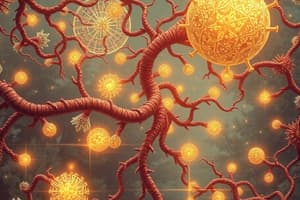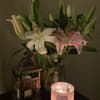Podcast
Questions and Answers
What molecule is characterized by having a long hydrophobic tail and a quinone head?
What molecule is characterized by having a long hydrophobic tail and a quinone head?
- NAD+
- FAD
- Cytochromes
- Coenzyme Q (correct)
Which of the following correctly describes FAD?
Which of the following correctly describes FAD?
- Contains a flavin molecule, two nucleotides, and ribose (correct)
- An electron carrier involved in cellular respiration
- Proteins containing iron-sulfur clusters
- Consists of two nucleotides, adenine, and nicotinamide
Which of the following describes Iron-Sulfur Proteins?
Which of the following describes Iron-Sulfur Proteins?
- Proteins that transfer electrons via NAD+
- Proteins containing iron-sulfur clusters (correct)
- Compounds that consist of two nucleotides
- Proteins that do not involve electron transport
What is a characteristic of NAD+?
What is a characteristic of NAD+?
Which of the following terms is associated with the concept of electron carriers?
Which of the following terms is associated with the concept of electron carriers?
What is the charge of an electron?
What is the charge of an electron?
What happens to the potential energy of a compound when an electron is removed?
What happens to the potential energy of a compound when an electron is removed?
Which of the following compounds can act as an electron carrier?
Which of the following compounds can act as an electron carrier?
What is the role of reducing agents in chemical reactions?
What is the role of reducing agents in chemical reactions?
Which statement accurately describes the electron transport chain?
Which statement accurately describes the electron transport chain?
What is most energy stored in atoms mainly represented by?
What is most energy stored in atoms mainly represented by?
What are the two nucleotides that make up NAD+?
What are the two nucleotides that make up NAD+?
What is a compound that oxidizes another called?
What is a compound that oxidizes another called?
What is the main function of NAD+ during cellular respiration?
What is the main function of NAD+ during cellular respiration?
Which molecule is lipid-soluble and acts as an electron carrier in the electron transport chain?
Which molecule is lipid-soluble and acts as an electron carrier in the electron transport chain?
Which of the following statements accurately describes the role of cytochromes?
Which of the following statements accurately describes the role of cytochromes?
What component is primarily responsible for transferring electrons from NADH and FADH2 to the electron transport chain?
What component is primarily responsible for transferring electrons from NADH and FADH2 to the electron transport chain?
What do Iron-Sulfur Proteins primarily participate in?
What do Iron-Sulfur Proteins primarily participate in?
During which process do electron carriers facilitate the generation of ATP?
During which process do electron carriers facilitate the generation of ATP?
What is the structure of FAD (Flavin Adenine Dinucleotide)?
What is the structure of FAD (Flavin Adenine Dinucleotide)?
What role do electron carriers play in the processes of cellular respiration and photosynthesis?
What role do electron carriers play in the processes of cellular respiration and photosynthesis?
Study Notes
Electron Carriers
- Electrons are subatomic particles with a negative charge.
- The removal of an electron from a molecule lowers its potential energy.
- Removing an electron from a molecule is called oxidation.
- Adding an electron to a molecule is called reduction.
- Electron carriers are responsible for transferring electrons within cells.
- Electron carriers are important for cellular respiration and photosynthesis.
Types of Electron Carriers:
- NAD+ (Nicotinamide Adenine Dinucleotide): consists of two nucleotides, adenine, and nicotinamide. Transfers electrons to the electron transport chain after being reduced to NADH.
- FAD (Flavin Adenine Dinucleotide): contains flavin, adenine, and ribose. Transfers electrons to the electron transport chain after being reduced to FADH2.
- Coenzyme Q (Ubiquinone): is lipid-soluble with a long hydrophobic tail and a quinone head. Transports electrons from NADH and FADH2 to the electron transport chain.
- Cytochromes: proteins with heme groups (containing iron atoms). Facilitate electron transfer within the electron transport chain.
- Iron-Sulfur Proteins: contain iron-sulfur clusters. Participate in electron transfer reactions within the electron transport chain.
Electron transport Chain
- A series of electron carriers embedded in the mitochondria's inner membrane.
- Transfers electrons from electron carriers to create ATP, the cell's energy currency.
- Is important for generating the ATP needed for cellular function.
Studying That Suits You
Use AI to generate personalized quizzes and flashcards to suit your learning preferences.
Related Documents
Description
Explore the crucial role of electron carriers in cellular respiration and photosynthesis. This quiz covers key types such as NAD+, FAD, and Coenzyme Q, along with their functions and significance. Test your knowledge on how these carriers facilitate electron transfer within cells.





